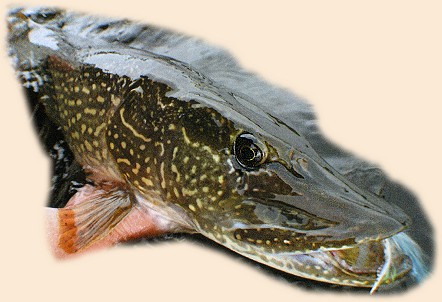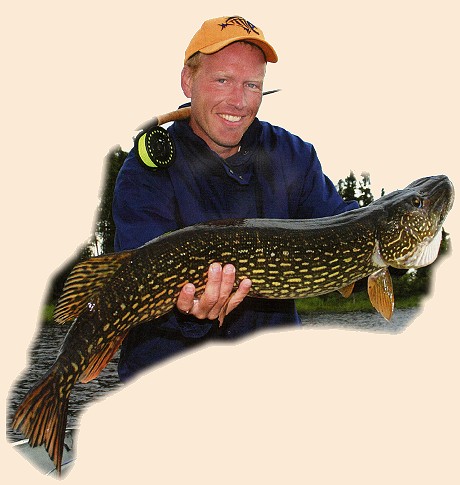Lake St. Joseph's Trophy Pike
By Nick Pujic
Tucked away deep in Ontario's boreal forest 300km north of
Thunder Day lies Lake St. Joseph - a large man-made
reservoir created in the 1930s by damming the legendary
Albany River system. The old riverbed still exists, easily
highlighted as the deepest part of the lake on a topographic
map. Besides creating the main lake, the impoundment linked
it with smaller nearby lakes, creating one very large body of
extremely diverse water - water which is being hail today as
the top pike and walleye fishery in Ontario.

Lake St. Joe is so large that one could spend weeks fishing
its 154,000 acres (approx.) and never see the same spot or
the same fish twice. The lake, which is 90 miles long and
nearly 20 miles wide in places, is a vast and complex maze
of islands, bays, coves and rock piles. These provide a
tremendous diversity of underwater habitat, ranging from
beautiful sandy beaches and shallow weedy bays to deep water
drop-offs and dramatic rock cliffs. Water depth varies from
under 6 feet in the shallower, more fertile bays to around
20 feet in most of the rest of the lake, with a few deeper
channels of 120 feet in the old riverbed. The collage of
underwater structure this creates and the abundant whitefish,
perch and cisco populations combine to produce a pike and
walleye fishery which is hard to match anywhere in Ontario,
and perhaps anywhere in Canada.
I visited Lake St. Joseph for the first time in June 2005
with my friend Mike Verhoef from Goderich, operator of Fly
Fitters guiding service and fly fishing school. Our main
intent was to hook into 40-inch plus pike on the fly. While
the Old Post Lodge where we stayed had not previously catered
to fly fishers, the owner, John Grace, was eager to have us
see what we could do.
Equipment and Flies
Because there was no fly fishing tradition on Lake St. Joseph,
we were facing the unknown and prepared ourselves for every
possible contingency. However, in the end we found that the
gear we needed was really quite basic.
A pair of 8wt 9 foot rods, coupled with durable disc drag
reels loaded with a floating rocket taper and an intermediate
sink tip line were all that was required. To cope with our
toothy prey, we used 6 to 8 inch fine wire leaders and, in
some cases, 501b braided tippet, which proved to be quite
effective. Leader length varied between 9 feet on the
floating line and 6 to 7 feet on the sink tips.
Our fly boxes were filled with various bunny strip type flies,
Enzol's minnows, large Clousers and Lefty's Deceivers. The
latter proved to be by far the most effective pattern. All
flies were tied on a very large scale, with hook sizes ranging
from 4/0 to 7/0. Casting these large puffs of fur and feathers
into the wind was a definite concern. However, after spending
a few minutes practicing and adjusting the cast we were
consistently able to punch out 40 to 50 foot casts without
much trouble. The main forage for pike in Lake St. Joe is
cisco and whitefish, and a big white and blue Lefty's Deceiver
provided the perfect imitation of these.
Tactics
The fishing in Lake St. Joseph is almost always dictated by
the weather. It's home to a prevailing westerly wind which
creates water currents throughout the lake, which are much
more significant than those created by tributaries. The colour
of the water is reminiscent of tea, with a maximum visibility of
about 6 feet a characteristic typical of most Northern Ontario
lakes.
If it had not been for Bill Briscoe, Old Post manager and
head guide, the vastness and complexity of the lake would
have baffled us. Besides taking us to where the fish were,
Bill shared his 13 years of experience of the lake with us.
What follows is a summary of what he gave us.
Spring
Fishing usually begins shortly after ice out, which generally
occurs sometime in May. The shallow, mud-bottomed bays warm up
first The dark, muddy bottom of these bays soaks up the sun,
especially along the northern shore of the lake where sun
exposure is maximized, creating a significant variance in
temperature between the main lake and the shallow bays. This
difference can be as much as 10 degrees Celsius, with the main
lake around 7 degrees and the shallower bays around 17 degrees.
The higher the variance in temperature, the easier it is to
locate trophy pike. Spawning activities usually get under way
shortly after ice out. However, Old Post guides have reported
seeing spawning activities even as the last few inches of ice
still decorated the surface of the lake.
During this time, large pike should be targeted in these bays.
Because of the murky water, flies should provide lots of action
and be big (5 inches to 6 inches) and bright. Bulky, oversize
bunny strip type flies in fluorescent chartreuse, hot pink and
red all worked well for us. Adding flash materials to these
didn't seem to make much difference. Despite the stained water,
it's possible to sight fish in shallow bays (between 2 and 6
feet) during this time. However, it does take a keen eye, and
a quality set of polarized glasses is necessary. The most
productive areas are shallow, dark-bottomed bays which have a
small tributary or creek feeding into them, as these seem to
have the highest concentrations of baitfish for the pike to
feed on.
Summer
As the Northern tea colored waters of Lake St. Joseph warm
up in the summer months, large pike become tougher to target
than in the spring. The end of the hex hatch usually marks
the end of the spring fishing season and indicates a change
in pike behavior throughout the lake. Most pike migrate to
moderately deeper waters as the shallows warm up. It's harder
to target them on flies in (he deeper water, as they're
dispered over a much wider area and it's impossible to
sight-fish for them. However, they're still consistently
catchable if your approach is modified accordingly.
There's not much cover in the early summer, as weeds have
only just started to grow, and pike concentrate in budding
weedbeds and troughs in 8 to 15 feet of water. The most
productive weed beds are those found on or in close proximity
to rocky points, underwater shoals or steep drop-offs.
We found that casting large Lefty's Deceivers and heavier
Clousers was very effective in these places. With the boat
50-60 feet away from the weedbed or structure and pointed
towards it, we'd cast 5 to 10 feet beyond it. Once the fly
hit the water, we gave it two or three 10 inch strips, then
waited for about five seconds to let it sink back towards
the bottom before starting another series of strips. [For one
of the more succcessflies used, see
Saint Joe's Deceiver]
This method was extremely productive during our visit not
only for pike, but also for walleye, which would intercept
the fly as it dropped between the retrieves. Never before
have I caught so many walleye as consistently or as easily
on a fly as I did on Lake St. Joseph. These fish, which
averaged 22 inches, with the biggest measuring out at 26
inches, were a perfect, hard fighting alternative when
trophy pike were elusive. Their aggressive attitude (after
all, they were taking 7/0 streamers without any trouble)
and sheer abundance were an unexpected highlight to our trip.
Catching 40-inch plus pike during the Summer is very much a
percentages game, as they are located in the same waters as
hammer handle pike and countless walleye. However, the more
casts you make, the more fish you'll catch and the better your
chances of ultimately hooking into a monster.
Fall
From the late summer and into the fall, pike enter a new behavioral
stage a feeding frenzy to build up calories for the winter months.
During this time, they tend to locate by underwater sand piles.
Mostly caused by the currents, these are a common phenomenon in
Lake St. Joseph and can be very productive when found behind
natural rock piles. The occurrence of these two types of
underwater structure in combination with large "cabbage" type
weeds creates natural hotspots for pike. The Old Post guides
agree that this is one of the best times to target huge, 40-inch
plus pike, which are locally dubbed "gators" or "snakes" due
to their stunning ferocity.

If you're an enthusiastic streamer-tosser like myself, this
is the perfect time of year to visit Lake St. Joe. Covering
plenty of water in and around these cabbage weedbeds with an
array of extremely large, flashy streamers such as Enzol's
Minnows, Clousers and Deceivers is sure to provoke heart-stopping
strikes and drag-melting battles. Focus on stripping your flies
along weed edges, or overtop of weedbeds, about 4 to 7 feet below
the surface in intermittent 12 to 18 inch bursts.
Winds permitting, topwater action can be at its finest early
in the mornings throughout out the latter part of August and
even into September. Popular bass bugs and STP frogs are top
choices for your fly box. However, don't forget your box of
subsurface patterns, as the winds can pick up quite quickly,
rendering poppers and gurglers ineffective.
Conservation
An essential key to the success of the fishery on Lake St. Joseph
is its strict conservation policies policies which were largely
spearheaded and implemented by John Grace's initiatives in
cooperation with the MNR and local native groups. While most
fishing lodges face an uneasy pressure to allow anglers to
keep trophy fish, the Old Post was one of the first to institute
a no-kill policy on all pike caught, regardless of size, and a
keep limit of just two walleye over 18 inches per angler. The lodge
has also banned the use of landing nets, since research indicates
that landing nets are the primary killer of released pike stripping
their bodies of natural protective mucus and leaving them very
susceptible to bacterial infections, which can frequently lead
to death. Similarly, barbed (pinching down the barbs is OK) hooks
and trailer hooks are also banned at the lodge. However, from
experience I can attest that we didn't need either of these.
An innovative Lake St. Joseph tag system has also been developed
to control the annual angling pressure on the lake, setting strict
limits in which both the tourism and fishing industries can both
be sustained while improving the fishery. Progress is monitored
by lodges and the MNR annually to ensure the policies which were
set in place are, in fact, productive.

The conservation-minded thinking and hard work of John Grace and
others like him are definitely getting results, and no one can
attest to that more than those who visit Lake St. Joseph and
indulge in its pristine wilderness, its beauty and, of course,
its unparalleled fishing.
Getting There
Reaching Lake St. Joseph doesn't have to be complicated or
expensive. Daily flights into Thunder Bay are available from
most major airlines. Pickup from the Thunder Bay airport can
be arranged with the Old Post lodge. Visitors can also fly
into the Northern Ontario community of Pickle Lake, only 25
minutes North of Lake St. Joe. Another convenient option
exists for visitors originating from Southern Ontario with
chartered flights from Goderich directly to Pickle Lake via
Old Post charters. If arriving by land, simply follow Hwy 599
North from Thunder Bay. International chartered bus trips are
also available, depending on your point of origin.
Old Post & Village Contact Information
SUMMER:
P.O. Box 380, Pickle Lake
Ontario, Canada POV 3AO
Phone: 807.928.2802 or 807.928.2770
WINTER:
P.O. Box 336, Goderich
Ontario, Canada N7A 4C6
Phone: 519.524.1173
Toll-Free: 800.461.1388 ~ Nick
Credits: We thank the Canadian Fly Fisher and Nick Pujic
for re-print permission!
Our Man In Canada Archives
|

